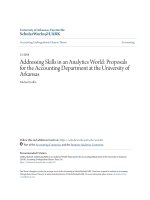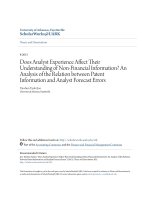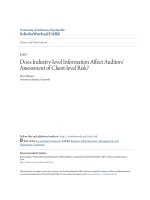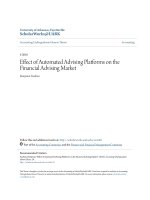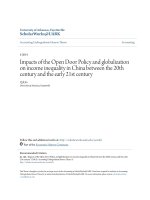Accounting undergraduate Honors theses: Effect of automated advising platforms on the financial advising market
Bạn đang xem bản rút gọn của tài liệu. Xem và tải ngay bản đầy đủ của tài liệu tại đây (1.78 MB, 20 trang )
University of Arkansas, Fayetteville
ScholarWorks@UARK
Accounting Undergraduate Honors Theses
Accounting
5-2016
Effect of Automated Advising Platforms on the
Financial Advising Market
Benjamin Faubion
Follow this and additional works at: />Part of the Accounting Commons, and the Finance and Financial Management Commons
Recommended Citation
Faubion, Benjamin, "Effect of Automated Advising Platforms on the Financial Advising Market" (2016). Accounting Undergraduate
Honors Theses. 24.
/>
This Thesis is brought to you for free and open access by the Accounting at ScholarWorks@UARK. It has been accepted for inclusion in Accounting
Undergraduate Honors Theses by an authorized administrator of ScholarWorks@UARK. For more information, please contact ,
University of Arkansas, Fayetteville
ScholarWorks@UARK
Accounting Undergraduate Honors Theses
Accounting
5-2016
Effect of Automated Advising Platforms on the
Financial Advising Market
Benjamin Faubion
Follow this and additional works at: />Part of the Accounting Commons, and the Finance and Financial Management Commons
This Thesis is brought to you for free and open access by the Accounting at ScholarWorks@UARK. It has been accepted for inclusion in Accounting
Undergraduate Honors Theses by an authorized administrator of ScholarWorks@UARK. For more information, please contact
Effect of Automated Advising Platforms on the Financial Advising Market
By
Benjamin Faubion
Advisor: Alexey Malakhov
An Honors Thesis in partial fulfillment of the requirement for the degree
Bachelor of Science in Business Administration
Accounting
Sam M. Walton College of Business
University of Arkansas
Fayetteville, Arkansas
May 13, 2016
1
Table of Contents
Introduction .................................................................................................................................................. 3
Robo-Advisors ............................................................................................................................................... 5
Fee Analysis ................................................................................................................................................... 7
Portfolio Customization ................................................................................................................................ 9
Conclusion ................................................................................................................................................... 10
Tables...........................................................................................................................................................11
Bibliography ................................................................................................................................................ 18
2
Introduction
Beginning to plan and save for retirement is a daunting task for the average working
American. Throughout the course of one’s professional career it is important to put aside a small
portion of annual income in hopes to retire with a standard of living equal to or better than the
current. In planning for retirement many individuals seek advice on saving strategies and
investment options from financial advisors, who specialize in structuring personal investments.
Over the past several years a new competitor has entered the financial advising market.
Automated advising platforms, often referred to as Robo-Advisors, are software driven
financial advisors with the goal of providing trustworthy financial advice and investment
services to individuals and company retirement plans at a fraction of the cost of traditional
human financial advisors. The programs use similar strategies to human financial advisors by
measuring the risk level, time horizon, and financial needs/desires of investors, then creating a
personalized investment portfolio to achieve those goals. The process for developing a portfolio
around these goals is where the Robo-Advisor and human financial advisor differ.
When individuals first meet with a financial advisor the first step is to have a
conversation allowing the financial advisor to learn about the client, his/her family, and life
goals. From this information the advisor can plug this information into proprietary software to
develop risk profiles and time horizons for clients. While this comes across as an organic process
to advising clients, the process is no different with a Robo-Advisor. Robo-Advisors cut out the
middle-man and have clients manually input personal information into questionnaires not so
different from those used by a financial advisor. From the responses of the client, Robo-Advisors
then build personalized financial portfolios to achieve client specific goals.
3
Financial advisors are tasked with securing and growing the largest sum of money
individuals will ever accumulate throughout their life. When selecting a financial advisor, careful
scrutiny is required. The most common areas of comparison between financial advisors is on
performance and fees. Comparing performance between individual financial advisors is nearly
impossible. Fee structure is a much more comparable metric amongst financial advisors, and this
is where the Robo-Advisors find opportunity.
Financial Advisors make the majority of their money in two methods. First through
annual fees charged as a percentage of client assets under their control. These annual fees
average out to around 1% across the industry (Clements, 2015). Current Robo-Advisors are
charging customers fractions of that of traditional human advisors. The second money making
opportunity for financial advisors is by recommending and placing clients into mutual funds
from which they receive kickbacks. While Robo-Advisors will place clients into lower expense
ETFs instead of high fee mutual funds. Minimized investment fees have driven many investors
to replace their current advisor with one of the many Robo-Advising platforms on the market.
The following sections outline and analyze the key differences between financial advisors
and Robo-Advisors. First with a comparison of fees, the different advisors are compared,
contrasted, and the implications of different fee structures analyzed. Second with comparisons of
performance and an overview of the different financial instruments and strategies used by
advisors. Third is an overview of the customization ability for both human and Robo-Advisors.
Ending with a conclusion outlining the key points made throughout the thesis.
4
Robo-Advisors
In comparing different Robo-Advisors, the eight most prominent platforms were selected
for comparison; WealthFront, Charles Schwab Intelligent Portfolios, Betterment, WiseBanyan,
SIGFIG, FutureAdvisor, Vanguard, and Personal Capital. Below are brief descriptions of each
Robo-Advising platform and their advertised benefits.
WealthFront began in December 2011 under the leadership of Dr. Burton Malkiel, Chief
Investment Officer, with $7,685,010 assets under management. Today WealthFront holds over
$2 billion in assets under management. Boasted as being “the most tax-efficient, low-cost,
hassle-free way to invest”, WealthFront has operated as a pioneer in the Robo-Advising
marketplace with advanced tax, stock diversification, ETF, and indexing strategies (WealthFront,
2016).
Charles Schwab Intelligent Portfolios was a more recent entry into the Robo-Advising
marketplace, opening to the public in March 2015. The Intelligent Portfolio option was a
response by Charles Schwab to the booming Robo-Advisor trend, while still playing off the
reputation and name brand of Charles Schwab. Schwab states that “if you have time for a cup of
coffee, you have time to start investing with Schwab Intelligent Portfolios” (Charles Schwab,
2016).
Betterment was one of the first Robo-Advising platforms to hit the market, founded in
2010 by Jon Stein and Eli Broverman. Betterment offers investors a wide diversification of
investments, with options in over 100 countries. Offering excess cash investments and automated
portfolio rebalancing, Betterment grants investors the freedom to set up scheduled deposits and
not worry about maintaining their portfolios. (Betterment, 2016)
5
WiseBanyan, founded by Herbert Moore and Vicki Zhou in November 2013, promises to
be the world’s first free financial advisor. Investors will pay $0 management fees, trading fees,
and rebalancing fees upon launch. WiseBanyan promises investors a fully automated system
with daily rebalancing, reinvestment of dividend, and depositing. (WiseBanyan, 2016)
SIGFIG, originally started as WikiInvest in 2007 by Mike Sha and Parker Conrad,
operates an investment account consolidator and Robo-Advising platform. Investors have the
opportunity to migrate all their existing accounts under the SIGFIG roof, allowing for one-stop
easy access to different accounts, along with Robo-Advising platforms directed toward tracking
and achieving the future financial goals of clients. (SIGFIG, 2016)
FutureAdvisor was launched in 2010 by Bo Lu and Jon Xu, both using their background
of computer science and engineering to develop an investing platform for the modern age. Today
FutureAdvisor offers clients investment services and management for retirement planning,
college savings, and investment philosophy. FutureAdvisor offers clients value by aligning the
goals of their different existing retirement accounts for the future. (FutureAdvisor, 2016)
Vanguard Personal Capital is the most recent of the major investment companies’ forays
into the Robo-Advisor marketplace. Using its current Retirement Planner, Vanguard projects
investors’ financial needs and builds a portfolio and retirement plan around them. Vanguard
advertises that along with their advisors, investors can increase annual returns by 3% or more
(Vanguard, 2016).
Personal Capital, led by Shlomo Benartzi and Harry Markowitz, developed a RoboAdvising platform around the Modern Portfolio Theory. Personal Capital builds investment
portfolios around six investment asset classes; US Stocks and Bonds, International Stocks and
6
Bonds, Commodities and ETFs, and Cash. Personal Capital uses licensed advisors in conjunction
with their Robo-Advisor platform targeting clients with over $1 million in assets to invest.
(Personal Capital, 2016)
Fee Analysis
The true comparison and competitive advantage for Robo-Advisors comes in the form of
fee savings for investors. Traditionally a 1% fee is standard for an actively-managed account
(Clements, 2015). The Robo-Advising platforms studied all fall well short of the standard 1%
fee, with some charging no fee to investors for assets under management. Below, the selected
Robo-Advising platforms are compared on varying levels of invested capital and portfolio
performance.
Depending on income levels, investors will contribute varying amounts to their
retirement funds. In forecasting the projected contribution amount over the life of investment,
original contribution amounts are grown at accelerating rates until the model investor is 45 years
old, then begins to slow in growth until tapering out at age 60. When accounting for investment
level, investors were broken into Low, Medium, and High investment levels. The different
investment levels were created using a baseline national average retirement savings contributions
of $172,000 at age 60 (Collinson, 2015). With this information a low investment level
established at $137,977 in investments spread throughout the life of the investor. The medium
level of investment sets lifetime contributions to $241,459. Finally the high level of investment
assumes $344,491 lifetime contributions. All of these investment levels were then tested in
accordance with the Robo-Advisors fee structure and minimum account balance requirements.
7
The different investment levels were also tested along different levels of economic
performance in order to gain a total picture of the merit of each Robo-Advising platform in poor,
average, and above average performance levels. To establish these performance levels, a baseline
average performance was set at 9.0%, with a poor performance level at 3.0%, and an above
average performance level set at 15.0%. These different levels were then tapered over the life of
the investment to reflect rebalancing of portfolios in accordance with investor risk tolerances and
time horizons changing as they grow closer to and reach retirement age.
When the eight Robo-Advising platforms are compared along the basis of investment level
and economic performance, three platforms emerge as dominant. Betterment is the best of the
available Robo-Advising platforms due to the $0 account minimum balance and the relatively
low fees. WealthFront and SIGFIG battle for the second best Robo-Advising platforms.
WealthFront favors investors with less capital to invest and situations when the portfolios earn
average to below average returns. SIGFIG beats out WealthFront for investors with large
amounts of capital to invest and times when financial markets are seeing above average
performance.
WiseBanyan was the only outlier when comparing the fees of the different Robo-Advising
platforms. WiseBanyan advertises and charges a 0% fee for assets under management, which
would place them first amongst their competition. Unclear is the manner in which WiseBanyan
earns money. WiseBanyan states that their only source of income is through a la carté product
and services. While this appears transparent at first glance, WiseBanyan may have quite limited
investment options outside of those which would incur additional fees to clients.
8
Portfolio Customization
When comparing Robo-Advisors to human financial advisor’s fees are only half of the
equation. Investing at the most basic level is the process of selecting stocks, bonds, mutual funds,
or ETFs which will appreciate in value over the time held. Robo-Advisors and financial advisors
compare interestingly on this metric.
Traditional financial advisors work with parent companies or partner firms to offer clients
a range of investment options at varying price points. This allows the advisor to select from a
format of premade portfolio templates or currently operating funds for clients based on their
personal risk tolerance and time line. For most investors, they are never aware of the other
options available or do not have enough knowledge to question the advice of their financial
advisor. A joint study by the University of Chicago and the University of Minnesota found that
7% of financial advisors have been disciplined for misconduct (Woolley, 2016). The misconduct
in the study revolved around financial advisors inappropriately investing client funds, by placing
clients in incorrect funds to earn additional profit and making unauthorized trades on client
accounts. While these advisors are in the minority, they still pose a financial risk to anyone
willing to trust their financial future to a stranger.
Robo-Advisors have similar strategies to those of financial advisors, by taking client risk
and time sensitivity and building a portfolio to meet those goals. The Robo-Advising platforms
studied pull proprietary funds unique to each of the investing platforms. Vanguard, for example,
has access to the full suite of Vanguard investment funds, while platforms like WealthFront will
not have access. The funds available to a specific Robo-Advising platform should play the same
importance to investors as those available to a human financial advisor. The biggest strength of
9
Robo-Advisors come from commitment to client success. While traditional financial advisors
may hold ulterior motives when establishing and maintaining clients’ portfolios, Robo-Advisors
will provide consistent service to meet the clients’ specific needs.
Conclusion
Saving for retirement can be a daunting task, but with a little help, everyone can
successfully plan for and save enough money to have a stable retirement. Human financial
advisors have filled this role for many investors, but moving forward Robo-Advisors offer to
disrupt the established industry. Robo-Advisors are able to provide services identical to those of
financial advisors at a fraction of the cost. Investors are still provided with the same selection of
funds and investment tools with which to build their portfolios. Robo-Advisors also assure
investors a portfolio is built to match their specific goals, not serve any ulterior motives or
influences the advisor may have. Robo-Advisors promise to be the next step in the evolving
world of retirement planning.
10
Tables
Table 1 - Contribution Total at Low Contribution Level
11
Table 2 - Contribution Total at Medium Contribution Level
12
Table 3 - Contribution Total at High Contribution Level
13
Table 4 - Annual Contribution Amounts
14
Table 5 - Contribution Total with Poor Economic Performance
15
Table 6 - Contribution Total with Average Economic Performance
16
Table 7 - Contribution Total with Good Economic Performance
17
Bibliography
Betterment. (2016, February). Pricing. Retrieved from Betterment:
/>Charles Schwab. (2016, February). Intelligent Portfolios. Retrieved from CharlesSchawb:
/>73333120340&keyword=%2Brobo%20%2Badvisor&device=c&adposition=1t3&matchtype=b&ne
twork=g&devicemodel=&placement=
Clements, J. (2015, January 18). It’s Time to End Financial Advisors’ 1% Fees. The Wall Street Journal.
Collinson, C. (2015). Retirement Throughout the Ages: Expectations and Preperations of American
Workers. Los Angeles: Transamerica Center for Reitrement Studies.
Davis, A. (2015, December). The Rise of Robo-Advisors. Employee Benefit News, pp. 14-16.
FutureAdvisor. (2016, February). Retirement Advice. Retrieved from FutureAdvisor:
/>Gleeson, J. (2015, January). Meet Your Robo Advisor. REP, pp. 30-33.
Kitces, M. (2015, December). Robo Advisors Threaten To Disrupt. Modern Trader, pp. 26-29.
Kitces, M. E. (2013, June 17). Is Capital Loss Harvesting Overvalued? Crain's New York Business, pp. 2222.
Personal Capital. (2016, February). What It Costs. Retrieved from Wealth Management:
/>SIGFIG. (2016, February). SIGFIG. Retrieved from SIGFIG: />Vanguard. (2016, February). Vanguard Life-Cycle Funds. Retrieved from Vanguard:
/>Vanguard. (2016, February). Vanguard Personal Advisor Services. Retrieved from Vanguard:
/>WealthFront. (2016, February). Frequently Asked Questions. Retrieved from WealthFront:
/>WiseBanyan. (2016, February). The World's First Free Financial Advisor. Retrieved from WiseBanyan:
/>Woolley, S. (2016, March 1). It Just Got Harder to Trust Financial Advisors. Retrieved from
Bloomberg.com: />
18

